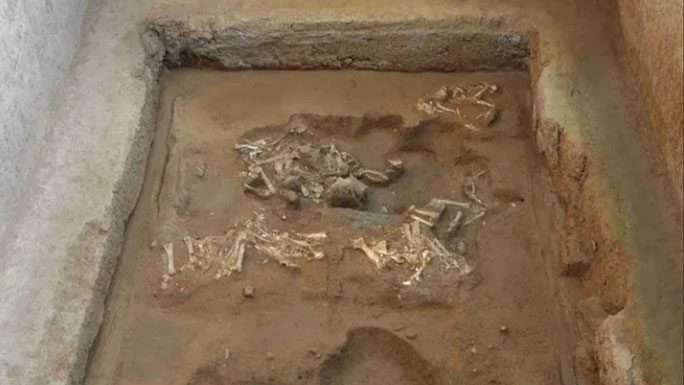The 2,000-year-old ruins revealed in the mausoleum complex of Qin Shi Huang belong to a peculiar chariot that has appeared in Chinese legends and history.
According to lead archaeologist Jiang Wenxiao, speaking to China Daily, it is a chariot pulled by sheep. Although the wooden chariot itself was likely destroyed after being buried for 2,000 years, the skeletons of six sheep that were used for pulling the chariot remain intact.
The six sheep skeletons were discovered in the “Western Tomb” area of the Qin Shi Huang mausoleum complex, located in Shaanxi Province, China, just a few miles northeast of Xi’an.
This excavation site is also close to the famous area with the Terracotta Army.

Remains of the sheep-pulled chariot in the “Western Tomb” of the Qin Shi Huang mausoleum complex – (Photo: Dayoo News).
Mr. Wenxiao also mentioned that horse-drawn and ox-drawn carts were very common in ancient China, but sheep-drawn carts are extremely rare.
They are mentioned only sparingly in Chinese history and legends, believed to be a type of “love chariot” of the king.
According to legend, the founder of the Western Jin Dynasty, Emperor Wu of Jin (Sima Yan), would ride a sheep-drawn chariot every night in the imperial harem and would sleep wherever the flock of sheep stopped.
As reported by Live Science, this tale has become the origin of the saying that modern Chinese people still use, “seeking fortune in a sheep-drawn chariot.” It is believed that the emperor had as many as 10,000 wives, thus requiring a random selection method using the sheep-drawn chariot.
Archaeologists presented their unique findings at the recent Chinese Archaeological Conference held in Xi’an, stating that they are still analyzing several items taken from the Western Tomb and hope to identify its owner.
In addition to the six sheep chariot, archaeologists also unearthed a four-wheeled wooden cart believed to be a horse-drawn carriage, which was equipped with an elaborately decorated rectangular canopy.
A multitude of bronze chariots and related artifacts, as well as iron tools and bronze weapons, were also excavated in the same area, providing insights into the early Iron Age in ancient China.

The Terracotta Army is the most notable monument in the Qin Shi Huang mausoleum complex – Photo: (Archaeology Wiki).
The entire Qin Shi Huang mausoleum complex, which was built during the reign of the first emperor from 221 to 210 BC, spans an area of 26 km2 and took 36 years to complete, according to ancient records.


















































